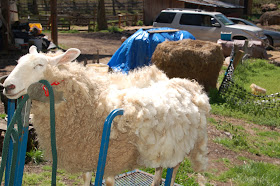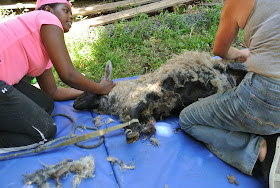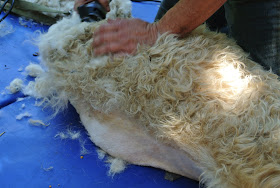An Extra Shearing
by Janet Garman
In all the years that we have owned fiber growing animals, we have sheared two times per year. Once in the spring and once in late summer. We always found that this kept the fleece short when the weather was warm and allowed for plenty of wool production, too. All was going well with the plan until this year
 |
| April 14, 2013 |
Early Spring around here, was unseasonably warm. I was actually ready to shear the sheep and pygora goats that we raise, so I went ahead and started shearing in late March. By the second weekend in April, all the shearing had been finished and I was ecstatic. Now I would be able to concentrate on gardening without the time consuming task of shearing taking up my weekend days.
 |
| Late March 2013 |
But then it turned cold. I don't mean chilly as spring can be, but cold. The animals were fine. Everything was fine, but the gardening had to be postponed. Finally, plants were in, seeds were sprouting and real spring arrived. For about a day and a half. In the Chesapeake Region of Maryland, spring is beautiful but fleeting. We seem to go from Winter to Summer in a single leap.
One day, I noticed that the fleece on the sheep was particularly long already. And now it was HOT outside. The goats, too, had more fiber than normal and they were itching and scratching. Some had managed to rub the fiber off their shoulders already. They were looking uncomfortable.
As things go, I had recently heard of a sheep shearer in the area.
I called, thinking I would not be able to justify the price of having the flock sheared by someone else. Especially, when I could do it myself. But, surprisingly, the price was very affordable! I booked an appointment and looked forward to the big day. My little flock would have a professional haircut!. The goats had been professionally sheared when we first had them and the nice family who did it taught me a lot about shearing. But then I did it myself from then on.
The big day dawned hot and steamy. I wondered if Anne would want to cancel. I was glad I would not be shearing today. Anne had estimated about three hours to complete all the animals. It takes me three weekends.
When Anne and her assistant Bri, arrived they got right to work. They used what they called the mat system, which they also use for alpaca shearing. The animal is immobilized by anchoring the feet, stretching the goat on his side and working on one side and then the other. The feet are also trimmed while the goat is immobile.
 | |
| If the goat had a lot of belly fleece, this was sheared off first, then the goat was placed in the restraints |
As you can see, the fleece was not in good shape already. It had begun to mat together and was mostly unusable. I am glad we were able to remove it all and let them begin growing new fleece for the next shearing.
Some shots of the boys sporting their new haircuts. Aren't they handsome?
Close up of the foot restraint system. While I think this system is good and enables you to work quickly, you do need to work on your knees. I would not be able to remain on my knees for the extended period of time.
Now that we are experiencing our second major heat wave of the summer, I am extra glad that I had the flock sheared for the second time. They are so much more comfortable and it makes me feel better too. It is hard to look at something wearing a sweater in 95 degree temperatures. The whole shearing process for 10 animals took 3 hours. Anne knows her business and is professional and efficient. Her assistant calmed the animals and readily did what ever needed to be done. And me? Well, it did feel a bit awkward to just sit and watch the work being done. My only job was to catch the next animal to be sheared. My husband helped with that. So it was pretty stress free, even if it was 90 degrees in the shade.
The amount of time the professional shearing took versus doing it myself, might just make this worth the money to have it done again. I firmly believe that anyone who owns an animal needs to be able to perform the care necessary for the animal. Since I know that I can do the shearing and have done so for many years, if the money is available, I may find this option more cost effective and worth the expense.






























No comments:
Post a Comment